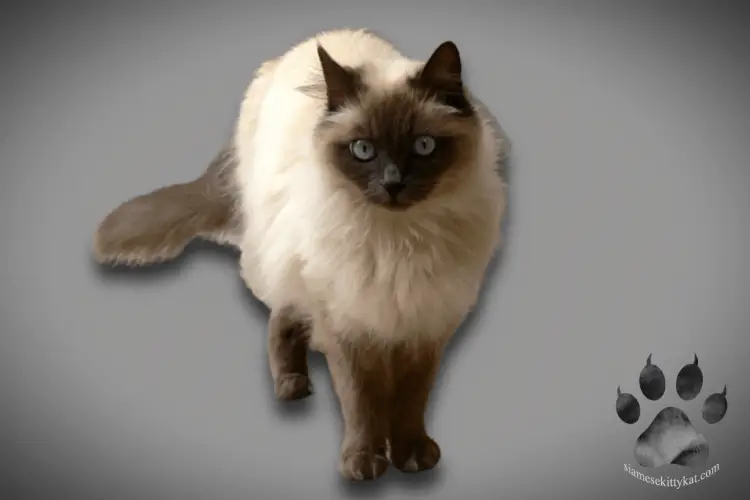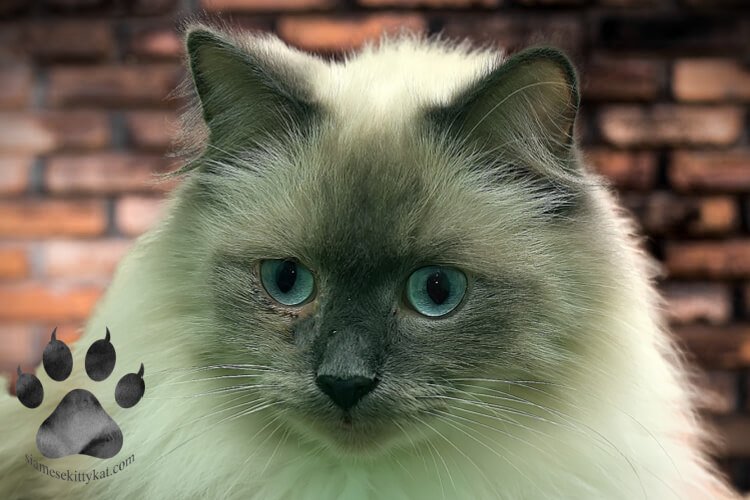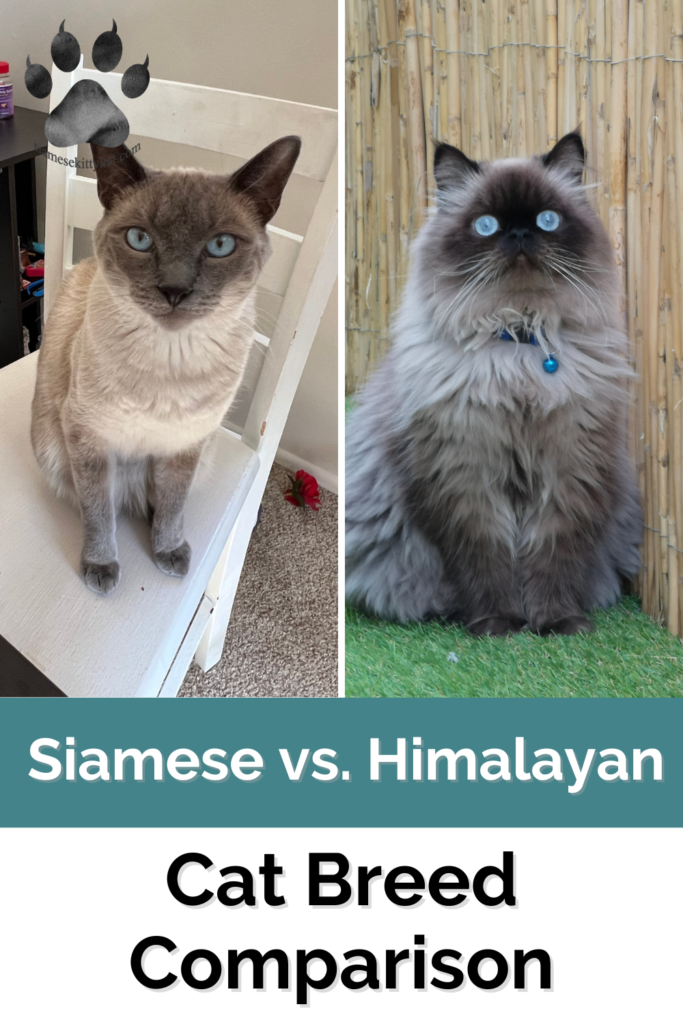These cats may look similar at first glance, but these two breeds have some clear distinctions.
The Siamese and Himalayan cats have their own unique history, appearance, and personality. While both breeds have blue eyes, that’s where the similarities mostly end.
Let’s take a closer look at the key differences between these two feline friends and see which one is best for you!
Is Himalayan the same as Siamese?
There is some confusion over whether Himalayan and Siamese cats are the same breed, but they are actually two different breeds. Himalayan cats are a type of Persian cat, while Siamese cats are their own breed.
Here are some key differences between them:
Origin
Regardless, the following breed registries recognized the Himalayan cat and the Siamese cat:
Physical features
Personality
Grooming
What two breeds make a Himalayan cat?

The Himalayan is a mix between the Persian and the Siamese. People know the Persians for their long, thick fur. They distinguish the Siamese for their slender bodies and striking blue eyes. They are as beautiful in person as they are on TV.
Together, these two breeds create the Himalayan cat. It has the best of both worlds – a luxurious coat and beautiful blue eyes.
Finding a cat that combines the best of both breeds is hard, but the Himalayan cat does that!
How do you tell if my cat is a Himalayan?
Himalayan cats have shorter legs than Siamese cats, and their bodies are more compact. They also tend to have a thicker coat, with longer hair around the face and tail.
In personality, Siamese cats are usually more vocal and active than Himalayan cats. They are also more prone to separation anxiety. They may become anxious or destructive if left alone for too long.
How much do Himalayan cats cost?
The cost of a Himalayan cat depends on various factors. These include the breeder, the cat’s age, and whether it is a pure breed. You can expect to pay from $200 to $2500 for a Himalayan cat. Expect to pay an extra $100 to $400 for veterinary care and routine vaccinations.
A breeder should not sell any kitten unless it got vaccinated against common viruses. These include the feline leukemia virus (FeLV) and the Feline immunodeficiency virus (FIV). These diseases are very common among purebred cats. They can cause serious illness or death if left untreated.
How much is a Siamese cat?
Siamese cats are among the most expensive cat breeds. A Siamese cat can cost you anywhere from $300 to $3000. The average price for a Siamese is about $200. That’s a wide range, but it’s what you should expect to pay when buying any cat breed.
The high price tag on a Siamese doesn’t mean that you can’t adopt it at an affordable rate. Many shelters have affordable adoption fees and even reduced prices on specific days. So, take advantage of these opportunities if they come your way!
How long do Himalayan cats usually live?

Their life expectancy is quite short. On average, a Himalayan cat might live up to 11 years.
Do Himalayan cats have health problems?
Yes, Himalayan cats do have health problems.
The Himalayan cat breed shares the same health issues as the Persian. Some lines suffer from plaque, tartar buildup, and gingivitis. Gingivitis causes periodontal disease, which leads to tissue, tooth, and bone loss.
Other common Himalayan cats’ health problems include:
1. Renal and urinary conditions
With polycystic kidney disease, the kidneys develop fluid-filled cysts that enlarge over time. Lethargy, excessive thirst, weight loss, and increased urination are symptoms of this condition.
Renal failure develops as the condition worsens at varying rates.
When I was still a child, I had a cat diagnosed with PKD. I didn’t know what it meant. All I knew was that I had to be careful. As time went by, my cat became more and more tired. He started losing weight, even though he ate the same amount of food.
The veterinarian assured us that there were options and that we would find the best treatment for my cat.
He did become stable after treatment. He managed his PKD pretty well.
Unfortunately, he died of old age. But, I remember the good old days with him sometimes.
The risk of developing calcium oxalate stones is greater in male cats and neutered cats.
2. Ocular condition
Himalayan cats have beautiful blue eyes. But did you know they’re also more susceptible to corneal sequestrum than other breeds?
Cats with this condition will develop a pigmented lesion in the center of their corneas.
Corneal sequestrum is a dark patch of dead tissue that grows on the cornea. It’s painful and produces excessive tears. If your Himalayan cat has this condition, it’s important to get them to the vet immediately.
3. Infectious condition
Cats are susceptible to several deadly viruses, including feline infectious peritonitis (FIP). This rare, generally fatal condition may result in moderate gastroenteritis. In some cases, it may show no signs at all. It is challenging to provide protection since kittens must be at least 16 weeks old to get the FIP vaccine.
Siamese cats’ health problems:
1. Ocular conditions
Glaucoma, a painful buildup of fluid inside the eyeball, is one of the causes of vision loss. The pupil may expand, the cornea may be cloudy, and the eyeball may appear bigger. It could result in blindness if not addressed right away.
Both are two different types of eye problems that can occur in Siamese cats. Convergent strabismus is when the eyes do not move in the same direction at the same time. Nystagmus is a shaking movement of the eyes.
These conditions are a result of several factors. These include injury to the eyeball, disease, and birth defects.
If you notice signs of these two conditions in your cat, take him to the veterinarian as soon as possible. The sooner your vet can identify the underlying cause, the better your cat’s chances of recovery will be.
It is a condition where the lens becomes displaced from its normal position. It may be primary (not associated with any other eye condition. It may also be secondary to trauma, glaucoma, or cataracts.
Lens luxation may cause pain, blurred vision, light sensitivity, and decreased night vision.
Progressive retinal atrophy is the degeneration of the retinal cells. Different kinds of PRA affect different breeds at various ages. All the cases still are bilateral and result in blindness. It causes progressive vision loss and then leads to complete blindness. Night blindness is often the first clinical symptom.
2. Gastrointestinal conditions
Pancreatitis is a condition in which the pancreas becomes inflamed. In most cases, this occurs due to a bacterial infection. This infection then causes inflammation within the pancreas. It results in lethargy and abdominal pain.
Amyloidosis is a disease where there is an abnormal buildup of protein in the body. This build-up can occur anywhere in the body. Still, it presents as protein deposits in organs like the kidneys.
In Siamese cats, systemic amyloidosis often presents with weight loss, vomiting, and diarrhea. It may also present as increased thirst and urination and a decreased appetite.
Treatment for systemic amyloidosis can include medications to help manage symptoms. It also includes the management of underlying conditions that could contribute to the disease.
3. Neurological condition
The symptoms vary from cat to cat, but one thing is for sure: it’s not fun for them.
Feline hyperaesthesia syndrome affects cats in different ways. Some display self-trauma by scratching themselves too much. Others will exhibit constant vocalization without reason.
Cat owners often try to soothe their pets by petting them when they are in this state. They also talk to them in a gentle manner. Some even play the music that they find soothing.
There is no definitive answer to what causes FHS. But, experts believe there are contributing factors such as skin irritation and stress.
I dived deeper into Siamese cats and the diseases they are prone to in one of my blog posts on this website. Check it out by clicking on this link: https://siamesekittykat.com/diseases-siamese-cats-are-prone-to/
Both the Siamese and Himalayan cats are excellent family pets. While you may find that you prefer one over the other, it’s impossible to go wrong with either.
Before making your decision, remember the key points when getting one of these breeds.
Be the Siamese Cat expert you always wish to be! From color points to similar cat breeds, discover everything you need to know about their unique charm and characteristics in our comprehensive guide: Siamese Cat Breed: Types, Color Points and Comparison to Other Cat Breeds
Get your FREE Siamese Cat 2026 Printable Calendar

